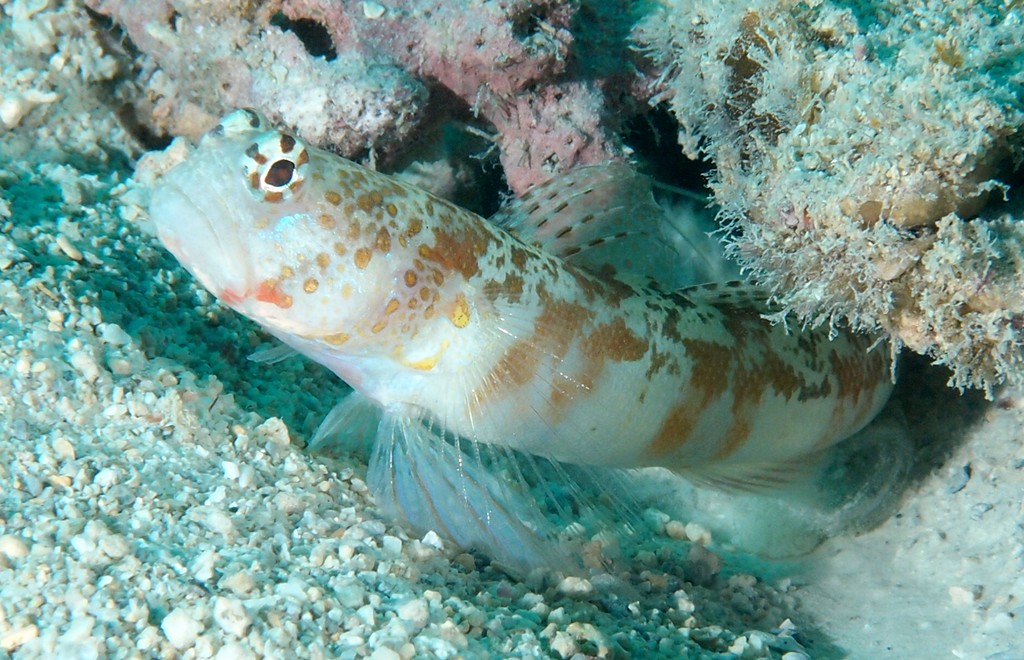AMBLYELEOTRIS PERIOPHTHALMA - (BLEEKER, 1853)
Actinopterygii (Gigaclass) > Actinopteri (Class) > Teleostei (Subclass) > Gobiiformes (Order) > Gobioidei (Suborder) > Gobiidae (Family) > Gobiinae (Subfamily) > Amblyeleotris (Genus)
Broad-banded shrimp-goby, Broad-banded shrimpgoby, Broadbanded shrimpgoby, Periophthalma prawn-goby, Blotched Shrimp Goby, Periophthalma Shrimpgoby, Slender Shrimp Goby, Tähystäjäraputokko, Dandara-datehaze,
Synonymes
Amblyeleotris maculata (Yanagisawa, 1976)
Amblyeleotris periophthalmus (Bleeker, 1853)
Cryptocentrops exilis (Smith, 1958)
Eleotris periophthalmus (Bleeker, 1853)
----------------------------------------------
Description
Dorsal spines (total): 7; Dorsal soft rays (total): 12; Anal spines: 1; Anal soft rays: 12. Characterized by whitish body color; head and side with six brown to reddish bars and irregular brown blotches in pale spaces in between; four branched main body bars on lower side; red blotch on lower cheek just behind mouth; red or orange spots on head, dark-edged; separate pelvic fins, joined by low membrane at base of fins; without median predorsal scales or only few embedded scales just in front of first dorsal fin; longitudinal scale series 80-85; greatest depth of body 4.6-6.4 in SL; caudal fin longer than head, 2.8-3.4 in SL. Max length : 11.0 cm SL. Depth range 5 - 35 m, usually 10 - 20 m.
Etymology
Amblyeleotris: from Greek, amblys or amblus = dull (blade: not sharp), blunt, obtuse + from the Greek name of a fish, eleōtris, found in the swampy waters of the Nile (Egypt) (from the Greek, eleios = who lives in the marshes). The name Eleotris appears for the first time in Déipnosophistes, a compilation of anecdotes and quotations from ancient authors, written by a scholar and grammarian Greek, Athenaeus of Naucratis (about 170-223 AD). In 1763, the Dutch naturalist and collector Laurentius Theodorus Gronovius (1730-1777) used this name to designate a new genus of fish. The authorship of the genre escapes him because his work was rejected by the scientific community of the time. The genre should have returned to the doctor, entomologist and naturalist of Italian culture, Giovanni Antonio Scopoli (1723-1788) but the late recognition of his work made him lose the authorship of the name. Today the genus, Eleotris, is attributed to Bloch & Schneider, 1801.
Distribution
Indo-West Pacific: Red Sea to Tonga, north to Japan and south to Australia. Reported from New Caledonia.
Biology
Inhabits coastal to outer reef sand slopes to 35 meters depth; on sandy areas of lagoon and seaward reefs. Inhabits burrows with alpheid shrimps.
Broad-banded shrimp-goby, Broad-banded shrimpgoby, Broadbanded shrimpgoby, Periophthalma prawn-goby, Blotched Shrimp Goby, Periophthalma Shrimpgoby, Slender Shrimp Goby, Tähystäjäraputokko, Dandara-datehaze,
Synonymes
Amblyeleotris maculata (Yanagisawa, 1976)
Amblyeleotris periophthalmus (Bleeker, 1853)
Cryptocentrops exilis (Smith, 1958)
Eleotris periophthalmus (Bleeker, 1853)
----------------------------------------------
Description
Dorsal spines (total): 7; Dorsal soft rays (total): 12; Anal spines: 1; Anal soft rays: 12. Characterized by whitish body color; head and side with six brown to reddish bars and irregular brown blotches in pale spaces in between; four branched main body bars on lower side; red blotch on lower cheek just behind mouth; red or orange spots on head, dark-edged; separate pelvic fins, joined by low membrane at base of fins; without median predorsal scales or only few embedded scales just in front of first dorsal fin; longitudinal scale series 80-85; greatest depth of body 4.6-6.4 in SL; caudal fin longer than head, 2.8-3.4 in SL. Max length : 11.0 cm SL. Depth range 5 - 35 m, usually 10 - 20 m.
Etymology
Amblyeleotris: from Greek, amblys or amblus = dull (blade: not sharp), blunt, obtuse + from the Greek name of a fish, eleōtris, found in the swampy waters of the Nile (Egypt) (from the Greek, eleios = who lives in the marshes). The name Eleotris appears for the first time in Déipnosophistes, a compilation of anecdotes and quotations from ancient authors, written by a scholar and grammarian Greek, Athenaeus of Naucratis (about 170-223 AD). In 1763, the Dutch naturalist and collector Laurentius Theodorus Gronovius (1730-1777) used this name to designate a new genus of fish. The authorship of the genre escapes him because his work was rejected by the scientific community of the time. The genre should have returned to the doctor, entomologist and naturalist of Italian culture, Giovanni Antonio Scopoli (1723-1788) but the late recognition of his work made him lose the authorship of the name. Today the genus, Eleotris, is attributed to Bloch & Schneider, 1801.
Distribution
Indo-West Pacific: Red Sea to Tonga, north to Japan and south to Australia. Reported from New Caledonia.
Biology
Inhabits coastal to outer reef sand slopes to 35 meters depth; on sandy areas of lagoon and seaward reefs. Inhabits burrows with alpheid shrimps.
